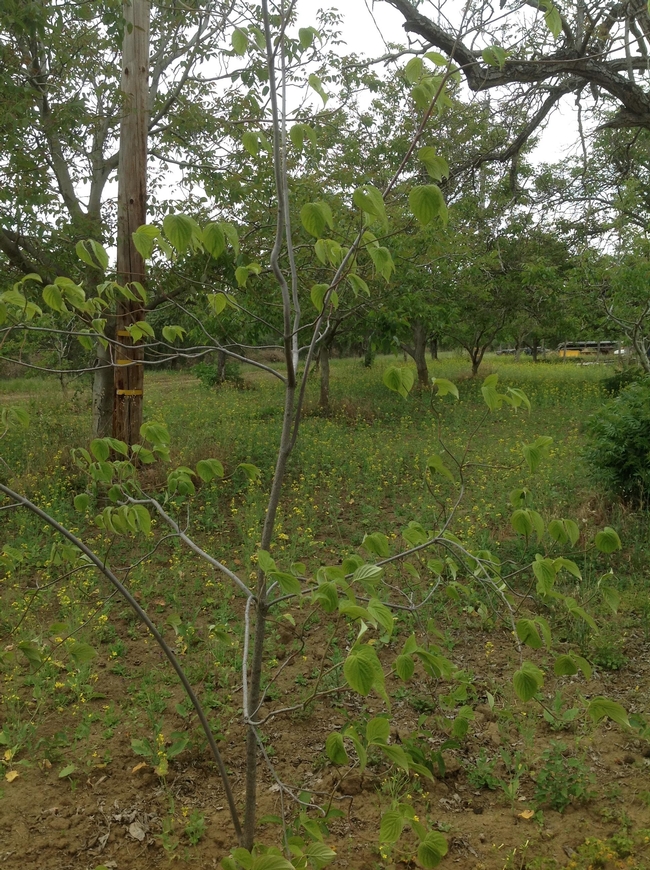Doris's Dogwood
You know how it's really nice to have a story to tell about something? Well, here's the story of Doris's dogwood tree....
We have known Doris's son, Tom, for nearly forever. Steve and Tom played basketball together in high school. We have lived together a couple times since Tom stood up with us when we got married. We lost touch when Tom moved away. We got back in touch a couple times when Tom was home to visit his folks, things like that. Well, I got to know Doris a little bit way back then, but after Tom moved away, I never saw her. Doris is an amazing gardener. When the horticulture program was started at the college, Doris was there and took all the classes. Way back then, she had a new home with views of her yard from every window of the house, even the master bath. She could sit in the tub and it was like being outside! (This was before everyone had hot tubs.). She planned and planted and planted and planted. It was wonderful to see. I was a little jealous because I wanted something like that if I ever grew up.
Anyway, Doris had a hip replaced and Tom was up to help her afterwards. We re-connected again and Steve helped him clean up around the house and yard so she could safely go back home independently. The yard had gotten out of control and they did some work out there also. So, Steve came home one day and said that Doris had a dogwood tree in a pot and it needed to go into the ground, but she didn't have space for it, did I want it? I have always wanted a dogwood tree, but I didn't think they could tolerate our climate, so I never really actively tried to have one. Anyway, he brought it home in the fall, and we got it planted out behind the gazebo after the fire came and went. She said it had been in the pot for at least 10 - 12 years, so I was worried that it might not survive, but as you can see from the picture, it did.
Doris invited me to come to the house a couple weeks ago. Mind you, I hadn't been out there in a good 30 years, so I was hopeful yet leery of what I would find when I got there. Doris took me all around the house and we had a great visit. She must have 10 dogwood trees in the very large front part of the property. She started many of them from the original tree that she put in. They were all in bloom. She proudly told me that she will be 92 on her birthday this month, but lamented that she can no longer get out in the yard the way she used to. Her mind is still sharp and she could name almost every plant out there, and there are MANY. Even though she hasn't been able to get out and work the way she wants to, the plants are in great shape. So, there's the story.
Now for the info, just in case you are interested. Dogwood is of the Cornaceae family, the most common being Cornus florida. There 6 species and they are native to Europe, Asia and America, primarily the eastern U.S., and can be found in zones 5 through 9. They are fast growing, as much as a foot a year. They like to be in partial shade, protected by larger trees, in slightly acidic soil, but they adapt well to all soil types. They are also drought tolerant, but like slightly moist soil. They will take full sun, but need more frequent watering during the hot weather if they are in full sun. Pruning is rarely necessary. However, if they need pruning, they are known to "bleed" sap profusely, so prune in early spring or summer. (I found different info from different sources). They flower from mid-March through May. There were only a few flowers on mine, but Doris's were in full bloom. The flowers can be large and fragrant and vary in color from white to pink to red. Doris only had 1 pink blooming tree, and it was BEAUTIFUL! Then the leaves come out and are rich green in color. One species has variegated leaves. In autumn, the foliage reddens. Then in the winter, the berries form and are white, red or bluish in color and about the size of raspberries. The bark also gets scaly looking and grayish in color during the winter. The pests associated with the dogwood tree are aphids, powdery mildew, anthracnose fungus and dogwood borers.
Just a little history and folklore..... The dogwood is the state tree of Missouri and the state flower of Virginia. Thomas Jefferson lobbied for the state flower designation, and planted the dogwoods at Monticello. George Washington planted dogwood trees at his Mt. Vernon estate. This made the dogwood popular as an ornamental tree.
In the 1500s, it was called "Dagwood" because the slender stems were used to make daggers, arrows and skewers - "Dags". Then it morphed to "Dogwood" because many thought that the sounds of the limbs knocking together on windy nights was like a dog barking OR because is was a popular treatment for mange by boiling the wood then washing the dog in the water.
The American Indians also used the dogwood branches to make toothbrushes! They used the bark and roots for medicines and dyes. The berries were used in religious ceremonies. The flowering was the sign that spring had come and it was time to start planting the corn. As the sap is poisonous, there were nefarious uses for the sap as well.
Last fun fact. The dogwood was used in making the first tennis racquets in Europe.
References: (all on-line)
Gardening Know how
Fast Growing Trees
Garden Design Magazine
HGTV

photo by Jenni Dodini

